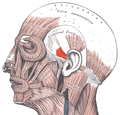Anterior auricular muscle
| Anterior auricular muscle | |
|---|---|
muscles of the auricula. Anterior auricular is at right (indicated by the red arrow). | |
| Details | |
| Origin | Temporal fascia |
| Insertion | Major helix (ear) |
| Artery | Posterior auricular artery |
| Nerve | Temporal branch of facial nerve |
| Actions | Pulls ear forward |
| Identifiers | |
| Latin | musculus auricularis anterior |
| TA98 | A04.1.03.020 |
| TA2 | 2089 |
| FMA | 46856 |
| Anatomical terms of muscle] | |
The anterior auricular muscle, the smallest of the three
Structure
The anterior auricular muscle arises from the lateral edge of the epicranial aponeurosis.[1] It inserts into a projection on the front of the helix.[1]
Nerve supply
The anterior auricular muscle is supplied is supplied by the temporal branch of the facial nerve (VII).[2][3] It may also receive some small branches from the auriculotemporal nerve, a branch of the mandibular nerve, itself a branch of the trigeminal nerve (V).[4]
Relations
The anterior auricular muscle is the smallest of the three
The superficial temporal artery, a branch of the external carotid artery, travels underneath the anterior auricular muscle to supply the auricle of the outer ear.[1]
Function
The anterior auricular muscle draws the auricle of the outer ear upwards and forwards.[1] This is a very subtle movement in most people, although some people can wiggle their ears.[1]
See also
Additional images
-
Auricula in context.
References
![]() This article incorporates text in the public domain from page 1035 of the 20th edition of Gray's Anatomy (1918)
This article incorporates text in the public domain from page 1035 of the 20th edition of Gray's Anatomy (1918)

